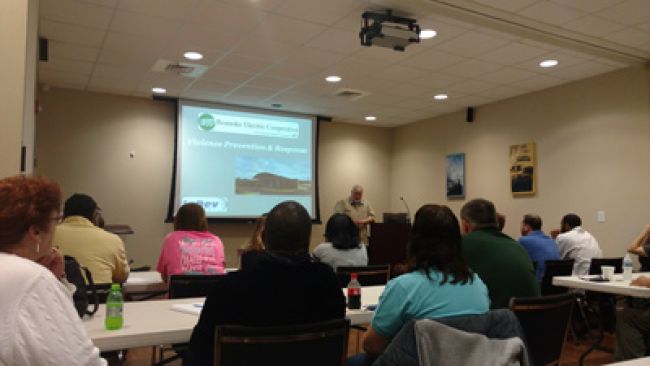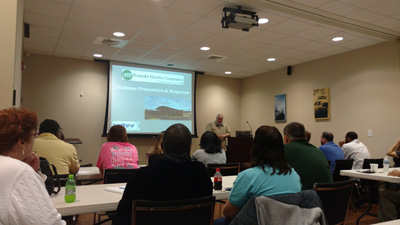
Rethinking Utility Security

The names Nathan Baker, Zackary Randalls, Alex Boschert and William Froelich may not be familiar to you, but their stories are tragically important for utility workers. Nathan worked for East Mississippi Electric Power Association in Clarke County, Mississippi. Zackary was employed by Pacific Gas and Electric Co. (PG&E) in Fresno, California. And Alex and William worked for Laclede Gas Co. (LGC) near St. Louis. Except for Alex and William, who were employed by the same company, there is no evidence that these men knew each other or their paths ever crossed, so what thread binds them together? They were murdered while doing their jobs for their respective companies. In a horrible twist of fate, three of the men were killed within a week of each other in 2017.
In 2012, Nathan was making a routine collection/disconnect call at a residence when he was shot; his body was dumped in one location and his truck abandoned in another. In 2017, Zackary was sitting on the passenger side of a PG&E truck when a gunman walked up to the window and fired at him. A few days later, Alex and William were connecting a residential natural-gas line when a man, believed to be upset about his electricity bill, shot the two men and then turned the gun on himself.
Troubling Reminders
These stories are troubling reminders of a trend of violence aimed at utility workers. Utilities go to great lengths to ensure their employees have the skills and training necessary to safely do their jobs, but there has been less of a focus on utility worker security. This has to change. It is time to rethink utility security. From the front door of the office to the crews in the field, we must change how we go about protecting employees. Lives depend on it.
When you mention “utility” and “security” in the same sentence, many people think of cybersecurity or physical security of large-scale infrastructure sites. Many have heard about the cyberattack on the Ukrainian electricity grid in 2015 and know about the steps taken in the U.S. to secure the grid. Some conceptualize utility security as protection against attacks like the one on the PG&E Metcalf substation – a major transmission grid link – that occurred in 2013. Although these are critically important security issues, they are not the only ones. Safety managers and senior staff with safety and security responsibilities also should focus on improving the security posture of utilities at the local level. This means securing office complexes, warehouses and operational facilities; taking steps to target-harden local transmission and distribution; and improving the protection afforded to both office and field personnel, whether company or contractor.
Utility employees have always had to cope with safety problems caused by the ever-increasing demands of population growth and rising consumption. And field crews have always had to deal with irate customers, aggressive dogs, bad drivers and a myriad of other hazards of the trade. In fact, there have always been times when utility security has been an issue, especially during major service interruptions resulting from natural disasters or extreme weather. But in recent years, a shift has been taking place in the social environment of the U.S., including the environment in which utility personnel operate, and not all of the changes have been positive. Unfortunately, some of these changes have weakened utility-customer relations and increased hostility and violence toward utility personnel.
What can be done? The very nature of the industry makes the answers complex. Employees have little control over where or when their work takes place. Whether on a manicured lawn, down in a rain-soaked right-of-way across private property or in the middle of the street, almost every place a utility works is going to adversely affect someone. So, the answer has to come from how we go about our work. There must be a conscious effort on the part of the utility and employees alike to improve security. This includes a command of the skills needed for situational awareness, verbal de-escalation and effective response to danger.
Situational Awareness
Utilities need to take a macro-level approach to situational awareness. They should regularly monitor local and national events for potential impact on their employees. For example, when the PG&E employee was killed last year, it would have been prudent for utilities to review operational procedures and ensure employees made situational awareness a priority in the days following the incident. This is the same advice I give to schools and churches following on-campus active shooter events.
Employees should take a micro-level approach to situational awareness. First, understand that situational awareness is fluid, and no one can be completely situationally aware at all times. For instance, if you are in a restaurant and have fully scrutinized the area, once you turn your focus to the menu, you are no longer actively aware of your surroundings. The same goes for the worksite. It is not possible to focus on task details and maintain full situational awareness. Therefore, you need to take steps to retain control of your immediate area and limit unobserved access. This means taking different steps at different worksites. At one worksite it may mean strategically locating equipment to create a barrier around the work zone, while at another, the solution may be adding a crewmember to monitor the surrounding area while other team members focus on the tasks at hand.
A critical element to effective situational awareness is understanding that overlooking the little things can lead to disaster. By observing the little things, you can maintain a reasonable level of situational awareness and control. Little things – like where and how you park your vehicle before turning your attention to paperwork – can save your life. For instance, parking off the street, and in a position that only allows individuals to approach from the front of the vehicle, will effectively narrow the area you need to monitor to a manageable size. Then you can concentrate on your paperwork while still having an opportunity to recognize approaching threats.
De-escalation
Some people handle verbal conflict with ease, but for most us, it is difficult and unpleasant. Utility workers are no exception, and de-escalation seldom is their go-to response to verbal aggression. The hazardous nature of utility work tends to attract Type-A personalities, so backing down is rarely their first instinct. The good news is that de-escalation is a learned skill, not a natural talent. The ability to skillfully de-escalate verbal conflict can be a life-saver. Personnel who regularly deal with the public should have the skills necessary to understand when and how to engage, and when to back down or escape a situation. Having the ability to recognize aggressive behavior and spot the warning signs of rising danger can help keep a situation from spiraling out of control.
Proactive Response
Knowing how to respond effectively to aggressors may be the most important skill that you can learn. Utilities should consider adding violence prevention and active shooter response to their mix of training programs. The wise training manager will look for security experts who understand the unique issues facing utility workers. Proactive violence prevention and active shooter training offers a twofold benefit to the utility: It will help protect their most valuable assets – their employees – and it meets OSHA guidance on the issue of workplace violence, which will help limit litigation exposure. Under the General Duty Clause, workplace violence and active shooter dangers are now considered recognized hazards.
The Takeaway
So, what is the takeaway from all of this? Simply put, times have changed, and utilities and their employees must be ready to deal with the changes. What is the best approach for handling these changes? Start with training and build from there. Provide employees with the skills needed to recognize dangerous situations, de-escalate verbal confrontations and effectively respond to violence. Seek out trainers who understand both security and the unique issues facing utility employees. It will pay dividends in the long run.
About the Author: Jim Willis, CMAS, is president of InDev Tactical, a security training and consulting firm that has provided security advisory assistance to utility, military, corporate, government, educational and religious institution clients for over 12 years. He has more than 40 years of experience in electric power, from lineman to substation engineer to director of special projects for NRECA’s International Programs division. Willis also is a credentialed homeland security specialist and anti-terrorism expert with expertise in counterterrorism, planning, training and security operations. He can be reached at jim.willis@indevtactical.net.

